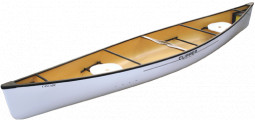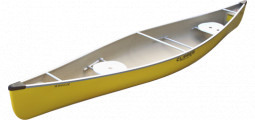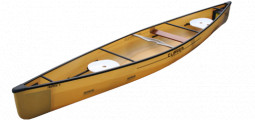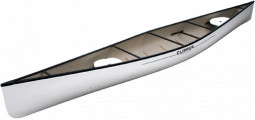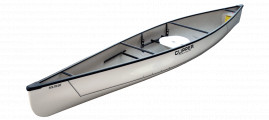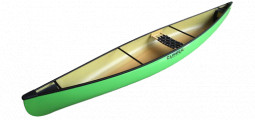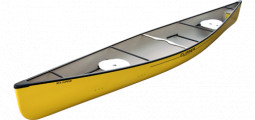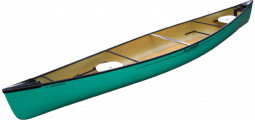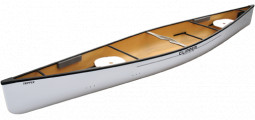Fiberglass was one of the first composite materials used to make canoes, and it has stuck around for a reason. Fiberglass canoes are the middle of pack within the canoe material world. They are generalists, landing between plastic and aramid/Kevlar when evaluated for price, weight, and durability. Compared to plastics, fiberglass canoes are stiffer and lighter. Compared to Kevlar, they won’t break the bank.
For canoeists, a fiberglass boat is a solid all-arounder for a range of casual tripping pursuits or a welcome addition as an everyday canoe. We’ve got some tips to help you find the best fiberglass canoe, whether it’s new or used. Read on to find out more.
Top picks: Best fiberglass canoes for 2024
The following fiberglass canoes have received the highest star ratings by reviewers in our Paddling Buyer’s Guide. See and review all fiberglass canoes here.
Best Fiberglass Canoes
Shop fiberglass canoes
Our Paddling Buyer’s Guide is a comprehensive guide to fiberglass canoe options. Whether you are looking for a tandem canoe for portage trips or a square stern to put a motor on, we’ve got the specs, prices and reviews in our guide. Links within the guide will also take you to dealers and places to buy the canoes.
If you aren’t sure where to start, keep scrolling through this article. We’ve got the answers to common questions that arise when buying a fiberglass canoe, along with helpful tips for finding used boats.
Shop by size
Shop by brand
Shopping for a used fiberglass canoe?
Keep these tips in mind as you begin what can sometimes be a daunting search through the used market for the right fiberglass canoe.
Look everywhere
The most obvious place to find a used fiberglass canoe is through online classifieds like Craigslist, Facebook Marketplace or Kijiji. Consider setting up alerts to be notified of posts as they arrive. Keep your search terms general, as many people may not be listing the specific make or model, simply just “canoe”.
Don’t stop there. Check with outfitters nearby, as many sell portions of their rental fleets at the end of each season. Renting one of these canoes is a great way to test the canoe out before you decide to buy it—we’ll touch more on that later.
Buy the canoe you need
Canoe designs are tweaked according to their intended use. Some canoes are best paddled loaded with gear; others paddle well when empty. Some are made for covering long distances, while others focus on being as stable as possible for photography or fishing. Be realistic with how you will be using your canoe.
Don’t fall into the “dreamboat” trap, buying a less stable, speedy canoe for that trip you may do eventually when, in reality, you’ll mostly be floating on the lake watching wildlife. Learn more about canoe design to help choose the best fiberglass canoe.
Don’t panic
Canoes are in short supply after the boom in demand for outdoor recreation during the summers of 2020 and 2021. You may feel that you need to take the first canoe you find. Be patient, and don’t jump on any old boat. Spring and autumn are times when people clean out their garages or sell off canoes to make space for new ones. Wait until you find a canoe that is a good fit—it will come.
Be realistic with your price
There may be a bit of sticker shock at the price of a fiberglass canoe if it is the first time buying it. After all, there’s no motor, electronics or even moving parts. So why does a canoe cost so much? Fiberglass canoes take time to make, and many companies are not operating on a mass-production scale. The materials, namely the cloth and epoxy, aren’t cheap either. This is why new fiberglass canoes are upwards of $2,000.
For used fiberglass canoes, expect the price to drop from sticker price by up to half, but they still do hold their value. Canoe design changes little year-to-year, and a well-cared-for canoe that is 10 years old is still a worthwhile purchase.
Every used fiberglass canoe is going to have scrapes on the bottom. These are normal and often superficial, as the coating tends to show every abrasion compared to plastic, which hides the scuffs much better. If the marks are deep enough to expose the cloth underneath, the canoe needs some repairs.
So don’t lowball in your budget. If you’re buying a canoe for $400, prepare to be looking for a while or settling for a junker.
Try it before you buy it
If you’ll only remember one thing, this is it. Pictures never tell the full story, and if you don’t actually get in the canoe on the water, you’ll never know how it handles. It’s a great way to gauge how comfortable the canoe is and how you feel in it. Some canoes are meant to be paddled loaded with gear, so bring a loaded pack or barrel for ballast. If the canoe is a different size from the one you currently use, double-check that your stuff fits in it.
For more tips on what to look for when selecting a used canoe, read our article How To Buy A Used Canoe.
Fiberglass canoe buying guide
Even if this isn’t the first canoe you’ve bought, it’s still helpful to consider the following steps to buy the best fiberglass canoe for you.
1 Assess your needs
Really think about the type of paddling you are hoping to do. Will you be cruising at the cottage or portaging smaller lakes? Are you paddling solo or with two people? The answers to these questions will dictate what type of canoe suits you.
2 Choose a canoe type
This is the step where you’ll likely decide if a fiberglass canoe is the one you want. Think of them as all-arounders, with qualities similar to aramid/Kevlar but at a much lower price. If you want to do some flatwater tripping, but weight isn’t an issue, then fiberglass is the right choice. It’s much lighter than plastic, at not much more of the cost.
3 Set your budget
Here’s where you can decide if you want to go new or used, or if there are other hard-to-find add-ons you want like a third seat, or reinforced keel strips. Depending on the shape, length and model, fiberglass canoes range from $1,400-$2,100.
4 Find canoes for sale
Check your local paddle shop for a fiberglass canoe. The staff there will be able to set you up with one that matches your needs.
5 Test it out
The only way to know if a canoe is good for you is to give it a shot. Jump in and paddle, and you will quickly know if you are comfortable in that canoe or not. Empty canoes feel very different compared to loaded ones. It may seem strange, but it is reasonable to bring a few items to load in the boat for ballast.
6 Don’t forget the gear
The money you’ll save by opting for fiberglass over Kevlar can go towards some of the other important items. A good paddle and comfortable PFD will make your time on the water much more enjoyable.
Want to know more? Find our answers to commonly asked questions about fiberglass canoes below.
-
Are fiberglass canoes any good?
Fiberglass canoes are good for canoeists looking for a budget-friendly boat that is still light enough to carry. They are lighter than the less expensive plastic options but cost less than ultra-light aramid composite materials. A fiberglass canoe is great for paddlers who want an all-around canoe that can handle light whitewater.
-
Fiberglass canoe manufacturers
Most of the common canoe manufacturers make their canoes available in fiberglass. Some manufacturers to consider are Nova Craft, Clipper, Scott, Trailhead and Wenonah.
-
Fiberglass canoe brands
Many fiberglass canoe brands feature other materials in their lineup. Settle on a shape you like and then choose the fiberglass option. Start looking at Nova Craft, Clipper, Scott, Trailhead and Wenonah canoes for inspiration.
-
How heavy is a fiberglass canoe?
A fiberglass canoe’s weight depends on its length, shape, and the outfitting. Additional layers of glass reinforcements and skid plates add pounds to the canoe. Wider canoes will weigh more as they use more material. Compared to other common canoe materials, fiberglass canoes are mid-weight. Kevlar and other aramid composites are lighter, and plastics are heavier.
-
16-ft fiberglass canoe weight
16-foot fiberglass canoes weigh around 60 pounds—possibly more or less, depending on the model. The addition of a shoe keel or bulkheads may add 5 to 10 pounds to the canoe. Trim options also affect the boat’s weight, with some customers adding wooden gunwales for a warmer aesthetic—but they will be heavier than aluminum ones.
-
How much does a 17-foot fiberglass canoe weigh?
Expect a 17-foot fiberglass canoe to weigh around 70 pounds. This may be altered by adding different upgrades like enhanced yokes, wooden gunwales or skid plates. The boat design may also affect the weight. If it is a deep-sided Prospector or the canoe has a shoe keel, more material will be used, causing the boat to weigh a few pounds more.
-
Fiberglass canoe durability
Fiberglass canoes are durable, but they do have a limit on the impacts they can withstand. As the material is stiff, the hull is more susceptible to cracking under repeated pressure than plastic materials that will bend and flex before cracking.
-
Fiberglass canoe prices
How much does a fiberglass canoe cost? New canoe costs depend on the size, model and manufacturer. Fiberglass canoe prices are mid-range among all canoe types, and the least expensive out of composite options—cheaper than aramid, Innegra or Kevlar blends. To compare fiberglass canoe prices across brands, consult our Paddling Buyer’s Guide.
-
How do you tell if a canoe is fiberglass or Kevlar?
Both fiberglass and Kevlar use woven cloth, and telling them apart may be difficult. Kevlar has a yellow hue to it, and fiberglass is clear or white. If the canoe has been painted, it may be difficult to figure out if it’s fiberglass or Kevlar.
If you know the model, you can look up the specifications on the company website and weigh the canoe to compare. If there is a registration plate, looking up the number with the manufacturer will give details on the material used, and when the canoe was made.
-
How long will a fiberglass canoe last?
If it is properly cared for, a fiberglass canoe can last decades. Proper storage is essential to ensuring a long life for your canoe. Ideally, storing the boat indoors will protect it from harmful UV. If that isn’t possible, storing the boat outdoors in a covered area, and off the ground will help protect it.
-
Do fiberglass canoes sink?
Many fiberglass canoes have bulkheads (also called float tanks) built into the bow and stern of the canoe to prevent them from sinking.
-
Kevlar vs fiberglass canoes
Kevlar or other aramid materials are another composite option for canoes. There is an inverse relationship between weight and price when it comes to composite canoes. This means that the lighter the canoe, the more expensive it will be.
Fiberglass canoes weigh more than Kevlar canoes but cost significantly less. Durability depends on how well-built the canoe is, but generally, fiberglass canoes can withstand more impacts than Kevlar canoes.
-
Wood vs fiberglass canoes
Wooden canoes still have major appeal among canoe lovers for the classic look and smooth paddling. They are either strip canoes or wood canvas boats. They’re made as D.I.Y. kits or from small-scale craftsmen and women. Because of the labour that goes into making the boats, they are not cheap. Wooden canoes require more maintenance and care than other canoes and must be stored properly to prevent the wood from warping or rotting.
Compared to fiberglass canoes, wooden canoes are expensive. Their main appeal is for those who love the traditional aesthetics and enjoy the rituals of maintaining them. Note, it’s possible for a canoe to be both wood and fiberglass, since many canoes constructed of wood have a protective shell of clear fiberglass laid up on the exterior.
-
Fiberglass vs plastic canoes
Fiberglass canoes are a tier above plastic canoes in price. With the price premium paid for fiberglass comes a weight reduction. Plastic canoes are known for their durability, and are suitable for serious river running. They can be bumped, bounced, dragged and dropped with little worry. Fiberglass canoes can withstand a fair amount of impact, but not nearly to the same degree as plastic boats.
Choose a fiberglass canoe if you plan on carrying portages more than running rapids. The slight increase in price pays for itself after the first 800 meter carry. Their stiff construction means they paddle better, having a sharper entry line to cut through the water more efficiently.
-
Polyethelene vs fiberglass canoes
Polyethelene canoes are cheap options for boats that can take a beating. These are ideal for summer camps or people running rapids who want the peace of mind that comes with added durability. They have a softer construction and can be seriously damaged with extended UV exposure.
Comparatively, fiberglass canoes require a bit more care. They shouldn’t be dragged across a portage but they can still handle hitting the odd rock. The higher price is more than justified as it can shave up to 20 pounds off the canoe.
-
Cedar vs fiberglass canoes
Comparing cedar and fiberglass canoes is sort of like comparing a classic car to an everyday sedan. The cedar canoe wins in the looks department, but the fiberglass canoe is more reliable and requires less maintenance.
-
Fiberglass vs aluminum metal canoes
Unlike aluminum, fiberglass canoes won’t freeze your hands on a cold morning and are quiet enough to let you hear your own thoughts while paddling. Weights may be comparable between an aluminum canoe and a reinforced fiberglass canoe.
Fiberglass canoes are easier to repair than metal canoes. They are also more popular now than aluminum canoes and so are easier to find, in more colors and trim options.
Fiberglass canoe reviews
Read the reviews of these fiberglass canoes to help guide your search. Does the type of paddling the reviewers do match what you want to do? Are they paddling in places similar to ones you plan to? Would any issues they mention be deal-breakers for you? The answers to these questions can help you whittle down your list of potential canoe candidates.



